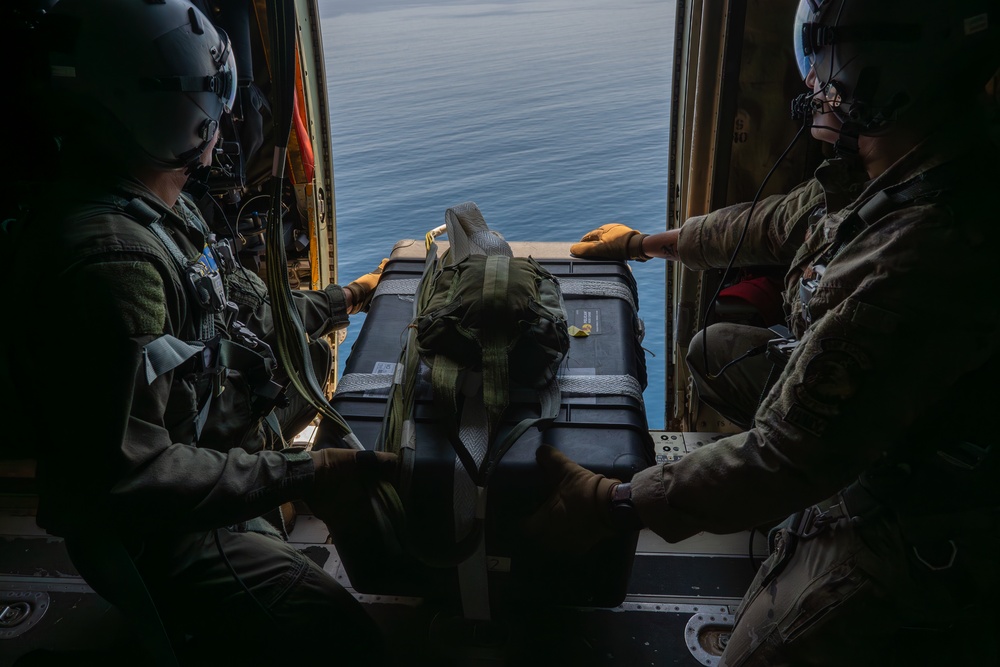
(e.g. yourname@email.com)
Forgot Password?
Photo By Senior Airman Erica Webster | U.S. Air Force Master Sgt. Aaron Broge, instructor loadmaster and joint airdrop…… read more read more
Photo By Senior Airman Erica Webster | U.S. Air Force Master Sgt. Aaron Broge, instructor loadmaster and joint airdrop inspector, and Technical Sgt. Everett Mead, mission loadmaster, both with the 913th Operations Support Squadron, prepare cargo for an airdrop over the Pacific Ocean on Aug. 10, 2024. During the exercise, loadmasters practiced rigging airdrop bundles and adapting tactics for delivering supplies to moving ships, improving flexibility and response times in real-world operations. (U.S. Air Force photo by Erica Webster) see less | View Image Page
On August 10, 2024, the 913th Operations Support Squadron participated in a joint-force exercise aimed at enhancing the group’s capability to support Navy and Marine Corps operations by validating new systems and streamlining procedures.
“We had three main goals for today,” explained Major Christopher Ansel, mission commander of the 913th OSS. “One was to validate the functionality of the Beyond Line-of-Sight commercial SATCOM hatch, which gives us a data link allowing a secure beyond line of site communications via satellite and chats.”
The ability to communicate securely, especially in remote or high-risk areas, is critical for mission success. The team confirmed that the system could provide reliable communication links, even when traditional radio methods faced issues.
“Without the hatch, I can’t say 100% that we would have been able to accomplish the airdrop today,” he added. “The radios didn’t work at first, and the hatch provided that bridge.”
With communication secured, the next focus of the exercise was on streamlining the airdrop process itself.
“We’re cutting out the middleman by training loadmasters to rig small airdrop bundles themselves,” explained Ansel. “Traditionally, airdrop bundles are prepared by qualified riggers from the Army, Air Force or Marines, but not all units we support have someone qualified to do this.”
The current process includes a movement of the item from a warehouse to a rigging shop to be prepared, then picked up and airdropped to a location out in the Pacific or Atlantic.
“That’s a four day process to complete plus all of the coordination of multiple flights is time consuming,” he said. “Now that our loadmasters can be qualified to rig their own door bundles, we can pick up that item anywhere a C-130 can land, and rig it in the airplane.”
In preparation for the exercise, loadmasters with the 327th Airlift Squadron, went through cargo rigging training, which included going over regulations and learning their responsibilities for the drop.
“There was a certified rigger from the 96th Aerial Port Squadron who helped us rig a few bundles before leaving,” said Master Sgt. Derek Johnson, joint airdrop inspector with the 327th ALS. “When it came time to rig our own bundles, it was easy. After completing the airdrop and coming home, we realized this process can be done by most of our loadmasters.”
Implementing this change not only allows for faster response times, but it allows for aircrews to become develop more flexible airdrop tactics. Specifically, refining their ability to accurately airdrop supplies to moving targets.
“We typically drop on a stationary coordinate but with ships, they’re floating out in the ocean,” said Ansel. “In a contingency or combat environment, they can’t sit in one place waiting for a drop.”
Adapting airdrop tactics for moving ships addresses a critical need in naval logistics, where flexibility and speed are paramount. This required bringing back older visual-based airdrop tactics, common with the previous generation of aircraft that had navigator crew positions.
“When the new C-130J arrived, we lost the navigator crew position,” he said. “Everything relies more on computer-aided solutions and the process became more rigid. It’s more accurate but with a ship, you can’t be rigid and we have to be flexible to account for moving targets. This exercise helped us refine that.”
With each of the three objectives validated, the 913th OSS is one step closer to their ultimate goal of creating a standard operating procedure for supporting a wider range of partners.
“There’s no real set standard for it yet, so today our goal is to set that standard and decide how we want to do things moving forward,” said Ansel. “We’re always looking to advancing the current state of things. The more changes and improvements we make now during peacetime, ensures we’re ready to deliver under combat conditions.”
Through participation in exercises like this, the 913th is able to refine tactics not commonly practiced, ensuring their Navy and Marine Corps counterparts are able to receive the same high-level of airdrop support traditionally offered to the Army. As global military dynamics continue to evolve, this adaptability will be key to maintaining logistical superiority in any operational theater.
This work, 913th OSS Advances Joint Communication and Airdrop Logistics Support, by SrA Erica Webster, identified by DVIDS, must comply with the restrictions shown on https://www.dvidshub.net/about/copyright.
No keywords found.
